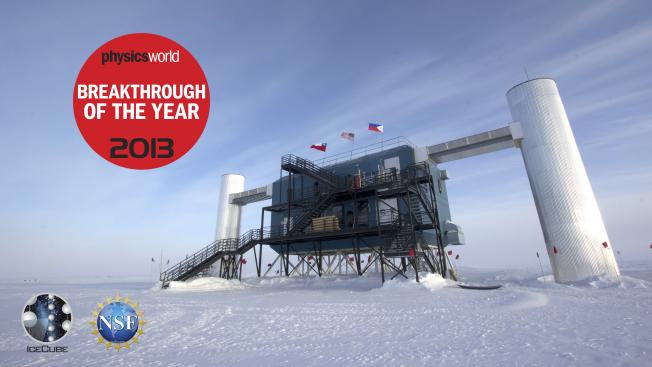Constraints on the Extremely-high Energy Cosmic Neutrino Flux with the IceCube 2008-2009 Data
ArXiv 1103.425 (2011)
Abstract:
We report on a search for extremely-high energy neutrinos with energies greater than $10^6$ GeV using the data taken with the IceCube detector at the South Pole. The data was collected between April 2008 and May 2009 with the half completed IceCube array. The absence of signal candidate events in the sample of 333.5 days of livetime significantly improves model independent limit from previous searches and allows to place a limit on the diffuse flux of cosmic neutrinos with an $E^{-2}$ spectrum in the energy range $2.0 \times 10^{6}$ $-$ $6.3 \times 10^{9}$ GeV to a level of $E^2 \phi \leq 3.6 \times 10^{-8}$ ${\rm GeV cm^{-2} sec^{-1}sr^{-1}}$.Light asymmetric dark matter from new strong dynamics
ArXiv 1103.435 (2011)
Abstract:
A ~5 GeV `dark baryon' with a cosmic asymmetry similar to that of baryons is a natural candidate for the dark matter. We study the possibility of generating such a state through dynamical electroweak symmetry breaking, and show that it can share the relic baryon asymmetry via sphaleron interactions, even though it has no electroweak interactions. The scattering cross-section on nucleons, estimated in analogy to QCD, is within reach of underground direct detection experiments.Background studies for acoustic neutrino detection at the South Pole
ArXiv 1103.1216 (2011)
Abstract:
The detection of acoustic signals from ultra-high energy neutrino interactions is a promising method to measure the tiny flux of cosmogenic neutrinos expected on Earth. The energy threshold for this process depends strongly on the absolute noise level in the target material. The South Pole Acoustic Test Setup (SPATS), deployed in the upper part of four boreholes of the IceCube Neutrino Observatory, has monitored the noise in Antarctic ice at the geographic South Pole for more than two years down to 500 m depth. The noise is very stable and Gaussian distributed. Lacking an in-situ calibration up to now, laboratory measurements have been used to estimate the absolute noise level in the 10 to 50 kHz frequency range to be smaller than 20 mPa. Using a threshold trigger, sensors of the South Pole Acoustic Test Setup registered acoustic pulse-like events in the IceCube detector volume and its vicinity. Acoustic signals from refreezing IceCube holes and from anthropogenic sources have been used to localize acoustic events. Monte Carlo simulations of sound propagating from the established sources to the SPATS sensors have allowed to check corresponding model expectations. An upper limit on the neutrino flux at energies $E_\nu > 10^{11}$ GeV is derived from acoustic data taken over eight months.Constraints on high-energy neutrino emission from SN 2008D
ArXiv 1101.3942 (2011)



